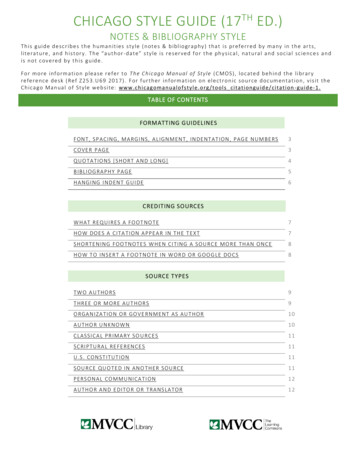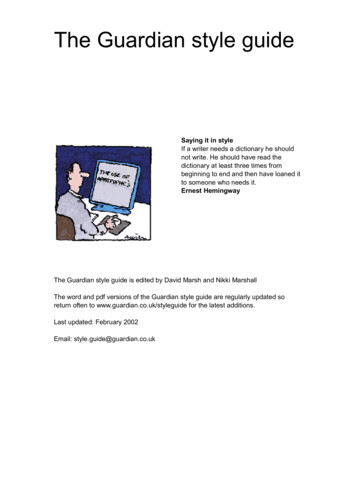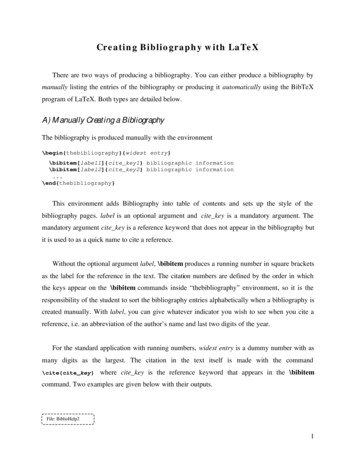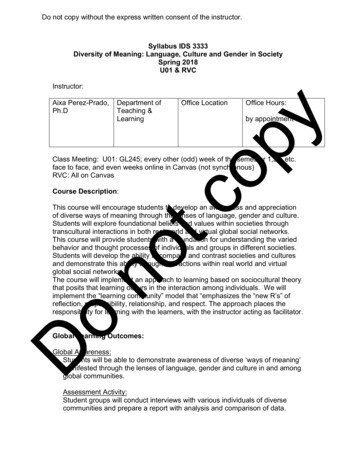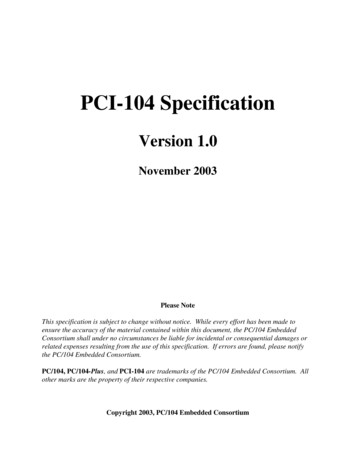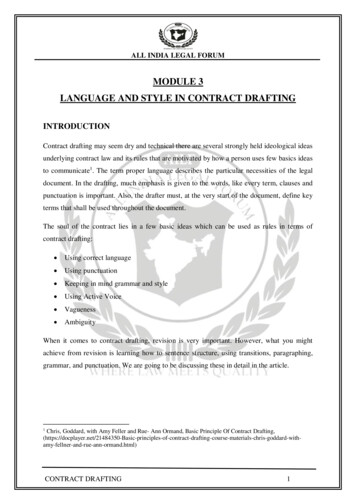
Transcription
ALL INDIA LEGAL FORUMMODULE 3LANGUAGE AND STYLE IN CONTRACT DRAFTINGINTRODUCTIONContract drafting may seem dry and technical there are several strongly held ideological ideasunderlying contract law and its rules that are motivated by how a person uses few basics ideasto communicate1. The term proper language describes the particular necessities of the legaldocument. In the drafting, much emphasis is given to the words, like every term, clauses andpunctuation is important. Also, the drafter must, at the very start of the document, define keyterms that shall be used throughout the document.The soul of the contract lies in a few basic ideas which can be used as rules in terms ofcontract drafting: Using correct language Using punctuation Keeping in mind grammar and style Using Active Voice Vagueness AmbiguityWhen it comes to contract drafting, revision is very important. However, what you mightachieve from revision is learning how to sentence structure, using transitions, paragraphing,grammar, and punctuation. We are going to be discussing these in detail in the article.1Chris, Goddard, with Amy Feller and Rue- Ann Ormand, Basic Principle Of Contract CONTRACT DRAFTING1
ALL INDIA LEGAL FORUMUSING THE CORRECT LANGUAGEUsing the correct language means using plain English language and not legalese. Legaleserefers to the formal and technical language of legal documents2. It is important not to usearchaic terms such as hereinafter, hereby, as they do not present a contract with anythinguseful.The usage of legal pairs (e.g., good and sufficient) leads to unnecessary addition to thecontract and serves no purpose. To keep the contract simple, it is important to not use Latinor foreign expressions (e.g., bona fide). They will help you achieve precise language whichprovides firm standards for compliance and enforcement. It avoids vagueness3.Example - “Seller has not entered into any other contract or agreement to sell or encumberthe Property or any part thereof.” Here, “its” can replace “thereof.” This sentence can berewritten as “Seller has not entered into any other contract or agreement to sell or encumberthe Property or any of its parts.”4USING PUNCTUATIONAnother problem you might face in contract drafting is the undesirable drafting of longsentences. Good use of punctuation can be to cut short sentences to create a clear picture ofwhat you want to convey. Rearrange long sentences: use punctuation surgically. Learninghow to use different punctuations will help you construct sentences strategically and it willeven appeal to the reader. It is easy to create ambiguity or uncertainty by wrong punctuation,or wrong positioning in the sentence of certain words.2Translegal se-2-2/)Chris, Goddard, with Amy Feller and Rue- Ann Ormand, Basic Principle Of Contract 4By Christina Costa & Muyiwa Odeniyide, TIPS FOR ACHIEVING CLARITY IN CONTRACT tractDrafting.pdf)3CONTRACT DRAFTING2
ALL INDIA LEGAL FORUMFor example, “Do it early in the first quarter” sets a shorter deadline than “Do it early, in thefirst quarter”. Likewise, 5Some Punctuation usedTHE COMMA (,) – The comma is the most used punctuation mark, by using coma extrainformation can be added in a sentence, coma is also used in coordinating dates, separatingitems, and writing quotes. Never use a comma between a subject and its verb, For example,do not use a comma between two subjects that share a verb or between two verbs that share asubject6THE HYPHEN (-) - Hyphens can be used between two words that function together tomodify a subsequent word in the sentence, as in “well-pled complaint.” Hyphens can also beused to connect some prefixes to wordsTHE DASH (—) - Dashes set off additional information or a modifying clause. As opposedto parentheses or commas, dashes create emphasis and give the impression that the addedinformation is important, surprising, or abrupt One crucial witness—the defendant’smother—refused to corroborate the alibi.THE SEMICOLON (;) - Semicolons connect independent sentences that are logicallyclosely related or work together as part of a larger idea. Semicolons tell the reader that moreinformation, following the semicolon, will clarify your meaning. They add emphasis to thesecond clause as an important explanation of the first.THE COLON (:) - Colons end a sentence that creates anticipation or suspense that the nextsentence or phrase resolves, Colons also introduce a list or introduce a quotation that is notintegrated into the writer’s sentence.5Chris, Goddard, with Amy Feller and Rue- Ann Ormand, Basic Principle Of Contract 6By Christina Costa & Muyiwa Odeniyide, TIPS FOR ACHIEVING CLARITY IN CONTRACT tractDrafting.pdf)CONTRACT DRAFTING3
ALL INDIA LEGAL FORUMKEEPING IN MIND GRAMMAR AND STYLEEnglish is a language that allows for a lot of playing around with tools like grammar. Englishhas many ways to describe obligation, rights, prohibition and permission, freedom to choose,and limits on that freedom.Here are some general guidelines:7 Obligation (an order)- You must do it, Do it Authorization (option)- You may do it Prohibition (a ban)- You must not do it Preference (a recommendation )- You should do it Intention (promise)- we will do it No obligation- you need not do itA few other rules would be to not use ‘shall’ in contract drafting as it could lead to potentialloopholes and it has several meanings that are easily confused, even by lawyers. Use “must”if you want to show obligation.Whenever there is a requirement or a condition to be stated, make sure to state it positively.Using double negatives can only create misunderstandings. Each negative adds to the risk oferror.USING ACTIVE VOICEWhat can be easily confusing when drafting is how to use active voice and avoid usingpassive voice. It is a general rule that when you are forming a contract, it is pertinent to usean active voice. A serious problem in legal documents is the overuse of passive verbs.Passive verbs hide responsibility and make sentences longer than needed.7Chris, Goddard, with Amy Feller and Rue- Ann Ormand, Basic Principle Of Contract CONTRACT DRAFTING4
ALL INDIA LEGAL FORUMExamples of Active Voice: The supplier will provide the Products or Services as specified in the Purchase Order. The supplier will begin work only after receiving a Purchase Order from Buyer. Buyer may request changes and Supplier will submit to Buyer the impact of suchchangesFor example, “Supplier shall deliver the Product to the Buyer” makes it clear that theSupplier (who is the subject of the sentence) is responsible to deliver (the verb of thesentence) the Product to the Buyer. Passive voice sentences are longer and can createconfusion. They can also de-emphasize the responsibility of the party. 8Possible cures1. Put a subject (the “doer”) before the verb.2. Cut part of the verb3. Use another verb.Usage of passive voice should be avoided but it can be used sometimes in the drafting.However, it should be used rarely. Two or three times a page is enough. Use passives whenthe doer of the verb is obvious, unimportant, or unknown 9. Another important tip would be touse ‘you” where possible. Without “you” it is almost impossible to avoid passives, especiallywhen stating obligations (imperatives).The cleanest way to avoid passives is to lead with verbs as commands, e.g., provide, avoid,include, perform. In this way, it is even possible to avoid “you must”. Active verbs becomenatural for writers who ask the important question – WHO does WHAT to WHOM? (ingrammar: SUBJECT VERB OBJECT).8Knowledge to Negotiate, Witing in the Active 10/12/writing-in-active-voice.html)9Chris, Goddard, with Amy Feller and Rue- Ann Ormand, Basic Principle Of Contract CONTRACT DRAFTING5
ALL INDIA LEGAL FORUMThese would constitute one of the defaults and mandatory rules that the writer has to followwhen drafting the contract. A few other rules to be kept in mind would be to keep sentencesshort up to an average of 15 words. If you go over 30, you run the risk that the reader mayhave a problem following you. As an author, you are responsible for communicating yourideas efficiently and effectively. Note the exception when using bullet points and lists. Try tokeep subjects and verbs together: a short interruption between a subject and its verb will notslow readers much. But along one will interfere with the communication process. Keepcompound verbs together: do not force readers to keep too much in their minds. Put verbsearly: let readers know what the sentence is going to do. 10VAGUENESS AND AMBIGUITYA contract language shows the clarity of thought that is going through the mind of the personwho is drafting the contract. Certain obstacles such as vagueness and ambiguity can confusethe reader and often lead to the interpretation boundaries that make way for non-essentialmeetings. Vagueness can also be expedient if addressing an issue precisely would makenegotiations longer or more contentions than one or both parties want. To avoid this, thisarticle will help you and discuss the following conceptsA contract is ambiguous if the contract is reasonably subject to more than one interpretation.Sometimes, this can mean that it is unclear as to what the parties intended overall. Butusually, an ambiguous contract means that a specific term, word, phrase, or definition isvague or unclear. One source of uncertain meaning in contracts is vagueness. Withvagueness, whether a given standard is met is a function of the circumstances 11.An example of a vague word in a contract is the word promptly. How fast a contracting partymust act to comply with an obligation to do something promptly is a function of what wouldbe reasonable under the circumstances. There is no specific deadline.10Chris Goddard, with Amy Fellner and Rue-Ann Ormand, Basic Principles of Contract Drafting(https://www.ulapland.fi/loader.aspx?id 60a15dd5-ebc6-4d06-a730-c363a4cf4327)11Kem Adams, A new taxonomy of vagueness in contract, gueness-in-contracts/)CONTRACT DRAFTING6
ALL INDIA LEGAL FORUMEven though many vague terms serve a useful purpose as they give hope of a loophole for thefuture, it is completely unethical to incorporate them into the contract. As a general principle,a contract should be clear about the obligations of each party.12With vagueness comes the possibility of dispute. A contracting party under an obligation todo something promptly might act fast enough that no one could reasonably say that they hadnot acted promptly. But the longer they take, the greater the likelihood of the other party’sdeciding that they had not acted promptly.That being the case, it would seem sensible to be specific instead of vague. Saying, forexample, no later than five days after instead of promptly after allows you to avoid thepossibility of dispute.13Drafters use vagueness whenever lack of control (over the future, over someone else’sconduct) renders precise standards unworkable. For example, if a provision requiringreimbursement of legal expenses might apply to a broad range of litigation, from the trivial tothe catastrophic, it might make sense to express a cap not as a specific amount but instead byreferring to reasonable legal expenses. 14There’s vagueness associated with the adjectives- reasonable, prompt, material, negligent,satisfactory, and workmanlike (among others) and any related adverbs. Vagueness using suchwords is assessed using a reasonable person standard.Reasonable-person vagueness fuels plenty of litigation. But floating vagueness incorporatesan extra measure of uncertainty. So use reasonable-person vagueness only when beingprecise doesn’t make sense or exacts too great a negotiation cost, and try not to use floatingvagueness at all.12We agree, accelerated contract drafting, ing-vague-terms-incontracts/#: :text us Contract, LegalMatch biguouscontracts.html#: :text s%20vague%20or%20unclear.)CONTRACT DRAFTING7
ALL INDIA LEGAL FORUMUsing gradations in vagueness like using the word grossly negligent instead of negligent. Ifyou decode it, it means that if negligent behavior is unreasonable behavior, grossly negligentbehavior is unreasonable behavior. How bad does behavior have to be to be grosslynegligent? This fact is not known. 15Avoid these things while drafting a vague contract1. Contracts mentioning contractual terms in the future. For example, the contract maystate that the parties will mutually agree to new prices every six months or that theparties will agree on including additional products to be subject to the contract eachcalendar quarter.2. Instead of agreeing on specific obligations and measurable criteria for objectivelydetermining if a party has met those obligations, entrepreneurs often agree to use“best efforts,” “commercially reasonable efforts,” “reasonable efforts,” “reasonablebest efforts, ”good faith efforts” or some other vague standard. Unfortunately, whenasked what the difference is between these standards, the parties do not agree.Contracting parties are more surprised to learn that courts frequently do not agree onthe meaning of these standards and the meanings will be different depending on thecourt interpreting the contract16.3. Rather than agree on a specific period for performance, contracts vaguely specify thatthe task must be performed “timely,” “as soon as practical,” “as soon as reasonablypractical,” “as soon as possible” or “immediately.” It is a much better practice tospecify the number of days by which each party must perform a task.15We agree, accelerated contract drafting, ing-vague-terms-incontracts/#: :text %2C%20materiality%20or%20reasonableness.)16David G. Bates, 7 ways to avoid signing vague contract, .html)CONTRACT DRAFTING8
ALL INDIA LEGAL FORUM4. Avoid defining critical terms in the contract and instead, generally refer to importantterms in the contract and hope the definition will be mutually agreed upon in thefuture.For example, referring in the contract to “profits,” “costs” and “revenues,”“reasonable expenses” or “standard quality,” or relying on what are perceived by theparties to be standard terms that in reality are not uniformly defined across theindustry or, in the case of a dispute, by expert witnesses.5. Do not include conflicting terms within the contract. Frequently, to avoid agreeing ona specific, mutually agreed-upon duration for the length of the contract, parties willenter into agreements specifying a one-, two- or three-year contract term andsimultaneously agree that either party may terminate the agreement at any time uponwritten notice.TIPS FOR ACHIEVING CLARITY IN CONTRACT DRAFTINGThere are few tips to achieve clarity in contract drafting Shall and will – the shall is used when referring to an obligation which is to becompleted by the parties, whereas the word will is used to establish futureconsequences of events and circumstances that do not obligate the parties Using May – The word may is used as the auxiliary verb in a statement permitting,but not obligated, a party to act in a particular way. the word “may” mean permissiveor discretionary unless the context indicates otherwise Short Sentences - Shorter sentences often make a contract more readable. As a ruleof thumb, if a sentence is longer than three lines, you should consider reworking it byeither reformatting the provision into sub-sections or breaking it up into two or moresentences1717specification writing guidance, (https://dipl.nt.gov.au/ data/assets/pdf klet.pdf)CONTRACT DRAFTING9
ALL INDIA LEGAL FORUM Try Not to Bury Verbs: In drafting your contract, try not to use abstract nouns at theexpense of verbs. This is often called “burying” the verb. Buried verbs allow you toavoid naming the actor like the use of the passive voice sometimes does. Use plural language – Using plural nouns or repeating nouns and avoiding genderspecific language, because it may mislead, distract, or offend some readers. Formatting Sections and Sub-Sections: An easy way you can add clarity to acontract is to use sections and subsections effectively. Using shorter sectionsgenerally makes a contract easier to read.CONTRACT DRAFTING10
Keeping in mind grammar and style Using Active Voice Vagueness . 4 By Christina Costa & Muyiwa Odeniyide, TIPS FOR ACHIEVING CLARITY IN CONTRACT DRAFTING . items, and writing quotes. Never use
